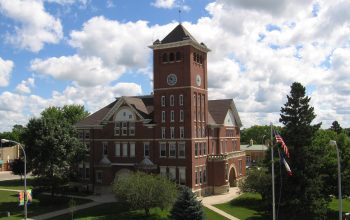Recently, one of the speakers at Memorial Day services at Graceland Cemetery in rural Rowan, was Jerry Aldrich. Jerry is a 1952 graduate of Rowan High School and former teacher at Alden where he still resides. During his Memorial Day speech, he shared the interesting story of a long past Aldrich family relative, Robert T. Rowen, who fought and lost his life in the Civil War. Highlights from that story as told by Jerry are below.
In his book "Horse Grove & Its Pioneers", Verle Crafton makes a brief mention of Robert T. Rowen as the third son of Robert Rowen, one of the very earliest settlers of Horse Grove, the precursor of the town of Rowan. Robert Rowen was the town's namesake.
The article in Verle's book describes the children of Robert Rowen, late of Connecticut and later of Cedar County Iowa. They were Elizabeth, who died at age four years in Thompsonville, Connecticut; John E, of Clarion, a man of some accomplishments as the United States Counsel to the Falkland Islands and the Republic of Chile; William, who was one of five men who drowned in the Iowa River at Belmond in 1870; Robert Todd, who is the subject of this piece; and Joseph H., a farmer who lived at the corner north of my brother Lee's tree farm in Iowa Township, and who was also my great grandfather.
In 1855, the Robert Rowen family, with Mr. & Mrs. Edwin Ballou and Horace Riley, arrived in Horse Grove, traveling by covered wagon from Cedar County, Iowa. At first, the Rowens lived in a crude 16 ft square log cabin and two years later built a home of sawn lumber, a house many of you may remember that sat across the road east from a present-day log home in Horse Grove. That house was burned some 25 years ago.
In 1861, the War of Secession began. President Lincoln prevailed upon the states to send volunteer militias to support the Northern armies. Robert Todd Rowen was 21 and he heard that a regiment was being formed at Dubuque to join the Union Army. At that time, the railroad had advanced westward from Dubuque only to Independence. Perhaps by stagecoach or railroad or horseback he got to Dubuque and joined the 32nd Iowa Volunteer Infantry regiment.
He must have been very early in the formation as he was assigned to Company A, one of ten companies that made up the regiment. By steamboat, the regiment went to Davenport and then to St. Louis and there the meager military training they received began. Later, again by steamboat, they moved into northeast Arkansas, were encamped there, and spent time in skirmishes with the Confederate Army.
A couple of highlights from the 32nd Iowa Volunteer Infantry Regiment – At one point "A" Company was aboard a United States Navy gunboat on one of the rivers about 60 miles northeast of Little Rock. The infantrymen were being shot at from shore. "A" Company was protected by bales of cotton on the deck of the gunboat, and they shot back with considerable success. At another time, the infantrymen of the 32nd Iowa walked behind a battalion of cavalry for several days and they kept up. That was no mean feat.
Eventually the regiment moved to a place south of Little Rock. At that point on November 30, 1863, Robert Todd Rowen lost his life. To the best of my knowledge, he was the first Rowan resident to die in the service of his country. To my knowledge, there are five others – Mortimer Hiams, Andrew Whitten, Morris Drury, Earl Hofsommer and Thomas Aldrich.
About two months ago, my son Steve and I were in Little Rock. There is a 37 acre plot in the city, the Little Rock National Cemetery, surrounded now by homes. There are over 12,000 soldiers buried in that cemetery. Almost all the sites are identified. A few say "unknown". Some say "Confederate". It is a quiet place. It left me with a sense of awe because of the size of it and of dread because of the finality of it.
We were determined to find the grave of Robert T. Rowen. It was a frustrating search and took us over an hour, but we did find it, thanks to some prior research. We may be the only family members to ever visit there. We cannot know. We do know that 158 years ago, a family member gave his life for his country, and in our family, he was not the only one.


